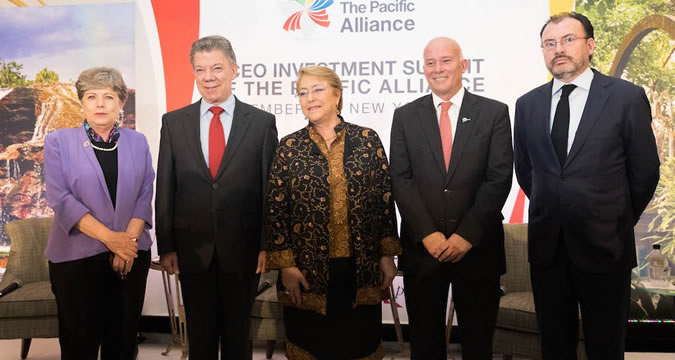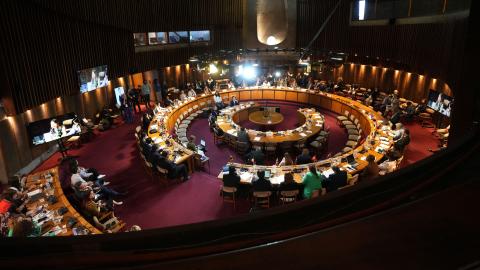Press Release
Alicia Bárcena, Executive Secretary of the Economic Commission for Latin America and the Caribbean (ECLAC), reaffirmed today in New York the regional organization’s support for the integration process of the Pacific Alliance, a mechanism formed by Chile, Colombia, Mexico and Peru, which she characterized as a successful experience founded on three key features: political will, public-private partnerships and pragmatism in decision-making and in the design of cooperation instruments.
“This is a project that creates enthusiasm and encouragement, that gives us hope that integration in the region is possible, so no one gets left behind,” remarked Bárcena in her capacity as moderator of the V CEO Investment Summit of the Pacific Alliance, attended by the presidents of Chile, Michelle Bachelet, and Colombia, Juan Manuel Santos, Mexico’s Minister of Foreign Affairs, Luis Videgaray, and Peru’s Minister of Foreign Trade and Tourism, Eduardo Ferreyros.
The meeting, held in the framework of the 72nd session of the United Nations General Assembly in New York, was organized by the Colombian Ministry of Trade, Industry and Tourism jointly with ProColombia and the Council of the Americas, with the support of other national promotional entities: ProChile, ProMexico and PromPerú.
Before an audience composed of international investors and representatives of multinational businesses, the authorities began by expressing their solidarity with the people of Mexico, just hit by a devastating earthquake. They then addressed the investment opportunities offered by the Pacific Alliance and the bloc’s progress and projections in terms of financial integration.
The presidents and ministers in attendance highlighted the economic and trade results achieved in recent years by the countries of the bloc in a context of economic slowdown and falling commodities prices. They placed particular value on solid fiscal policies, commitment to attracting foreign direct investment that contributes to productive diversification, the importance given to private initiatives, and policies of innovation.
Among the challenges that persist, they mentioned increased productivity in the four economies, the integration of value chains, technology transfer and the construction of a “brand” associated with the Pacific Alliance. During the discussion, particular attention was given to projects such as the Latin American Integrated Market (MILA) and the investment fund passport aimed at achieving greater competition between the member countries through capital movements.
According to its own definition, the Pacific Alliance, created in 2011, is an integration initiative focused on reducing trade barriers and fostering the free circulation of goods, services, capital and persons.
The bloc, which has 52 observer countries and represents the seventh-largest economy in the world, has begun negotiations with Australia, Canada, New Zealand and Singapore to join as the first associated States, the authorities indicated during the Forum.
According to ECLAC data, the countries of the Pacific Alliance received $64.793 billion dollars in foreign direct investment (FDI) in 2016, 14% less than in 2015 ($75.351 billion dollars). Of the total amount received by Latin America and the Caribbean in 2016, the bloc’s FDI accounted for 38.4%.
“The Pacific Alliance has been a great success for a region that needs to strengthen its integration” and show unity to the world, pointed out Bárcena, who called on attendees to look closely at global foreign direct investment trends: while a year ago they were mostly aimed at emerging countries, today they are going more to developed economies, she warned.



